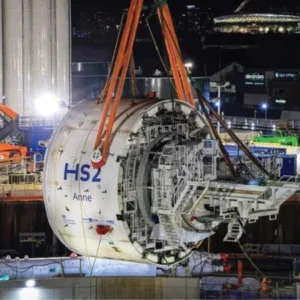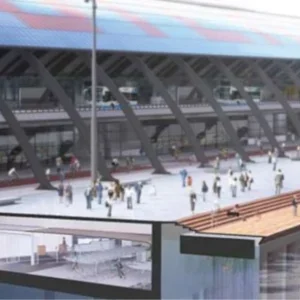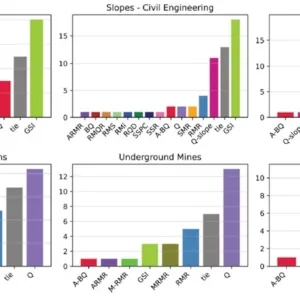Lorain, Ohio, situated alongside Lake Erie, is a city still recovering from the global recession and affected by the waning local steel industry. With unemployment wavering between 7 and 10 per cent, the city was in need of an employment generator — a need that was answered with a large, EPA-mandated tunnel project whose construction began in 2012. The Black River Conveyance and Storage Tunnel is the city’s answer to prevent sanitary sewer overflows into the waterway. City officials have said the tunnel will also help cut down on residential basement flooding during heavy rains.
In 2000, the Ohio EPA ordered the City of Lorain to address overflows that violated the City’s National Pollutant Discharge Elimination System (NPDES) permit. After studying options, including the construction of an equalisation basin in downtown Lorain, a deep tunnel option was selected. In order to construct the tunnel, the city required the assistance of a USD 65.87M loan from the Water Pollution Control Loan Fund through Ohio EPA’s Division of Environmental and Financial Assistance.
Vision
Originally, the tunnel was planned as a component of a plan to move the city’s Black River Waste Water Treatment Plant from the river mouth to a site upriver behind steel mills. However, a regional wastewater study recommended several cities join and use Lorain’s Philip Q. Maiorana Wastewater Treatment Plant for sewage treatment, making it unnecessary to move the Black River Plant.
The major components of the Black River Tunnel include the launch shaft and reception shaft – approximately 11m in diameter and 50m deep – and the main 1.7km-long tunnel with a finished diameter of 5.8m. The project route runs along city property roughly parallel to the Black River, beginning at the launch shaft near the Black River Wharf and terminating near the Black River Wastewater Treatment Plant. A screening facility will be built at one end near the wastewater treatment plant, where water will be diverted into the storage tunnel, and a pump station will be constructed at the launch shaft site. When complete, the pump station will move water from the storage tunnel back into an existing sewer interceptor.
Work begins
A joint venture of Walsh, Chicago, and Super Excavators, of Menomonee Falls, Wisconsin, was the low bidder for the project in 2012 with a bid of USD 52,000,243. Electrical work under a separate contract brings the total construction bid price to USD 55.4M. Ric-Man Construction was subcontracted to build the shafts.
Construction of the main tunnel began in late Autumn 2013 with a 7m diameter Robbins Double Shield TBM and continuous conveyor system running at the site. The mammoth machine was built using Onsite First Time Assembly (OFTA) – a Robbins-developed method that saves contractors in shipping time, costs, and man-hours worked.
Using the OFTA approach, individual systems are tested prior to delivery but the machine is never fully assembled in the shop. Robbins field service technicians work on location with the contractor to assemble the machine and provide support. Launch of the TBM took place on November 18, 2013 — approximately three months after assembly began.
"OFTA was a challenging process for everyone onsite. We had to make numerous adjustments. Regardless, our team worked diligently to overcome challenges, and we were able to get the TBM assembled and launched relatively close to schedule," said Mike Garbeth, project manager for Super Excavators. In addition to the TBM, Robbins supplied an in-tunnel continuous conveyor system and space-saving J-type vertical conveyor to provide more open area in the launch shaft.
Speedy Shale
The double shield machine was used in a unique manner during boring. "The shale is soft, so we are experiencing minimal cutter wear. We are installing ring beams and lagging, and there will be a final monolithic pour after tunnel completion," said Gregg Rehak, tunnel supervisor for Super Excavators, of the excavation during the winter of 2013/2014 Rather than concrete segments, ring beams were erected within the tail shield for installation as the machine passed. The lagging was spaced at 450mm intervals with wire mesh panels.
By February 2014, the machine had excavated about 40 per cent, or 640m, of its 1,700m bore, averaging 15m per 10-hour shift, with some shifts reaching up to 24m of advance. "We are in Cleveland shale, with some raveling seams. We’re just moving right along," said Rehak of the operation at that time.
He continued: "The shale is so soft, we can fly right through it and sometimes the conveyor has a hard time keeping up with it. Overall, it’s a good system, and it’s getting the job done for us." With record cold temperatures last winter plunging to -15oF (-26oC) without the wind chill factor, the crew had to be watchful for equipment freezing up, but wound up having minimal issues and no major breakdowns.
By the time of the machine’s breakthrough on April 29 the TBM was averaging 21m per day, and getting up to 24m per day for multiple days in a row. Contractor Super Excavators was proud of the TBM’s success, and that they were able to use local help to build the tunnel.
"Our team was able to adapt and learn," said Rehak. "We were able to hire locals and do on-the-job training with them." Not only did this boost the town of Lorain’s economy by creating jobs, but it also gave local construction workers experience in the tunneling industry.
Cleveland shale made for speedy excavation; so fast that it was challenging for the continuous conveyor system to keep up at times. The contractor confirmed that the TBM was mining so fast it could not excavate at its maximum rate. Rehak explained that the fairly soft ground also made for minimal cutter wear: "We only changed seven cutters during the bore, four of which probably could have made it to the end, but were changed for precautionary reasons."
As for the biggest challenge, Rehak cites the ground conditions: "There were sections of tunnel that gave us a hard time but we were able to get steel ribs jacked up into place and do some excavation behind them."
He estimates about 13 sections of bad ground 30m across, or about 25 per cent of the soft shale geology, made ground support difficult. Those sections consisted of layered and laminated rock that broke from the tunnel crown before ring beams could be expanded, requiring extra chipping and rock relief to expand each rib to the correct diameter.
Once workers fine-tuned the technique, they were able to do 12 to 14 rings per day – compared to just one or two rings before the process was refined – even in the sections of bad ground. In more stable sections production averaged 18 to 20 rings per day – a rate the contractor considers very good considering they were erecting steel ribs.
Now that tunneling is complete, a final monolithic pour will solidify the lining.
"The Robbins machine performed quite well," commented Rehak at the time of breakthrough. "Now we have to remove the TBM, which will take about four weeks; then rebar tying and concrete pouring can start." Final completion of the tunnel to bring it online is expected in spring 2015.
When finished, the tunnel will have a storage capacity of 42 million liters (11 million gallons) per day, providing a significant boost in water quality for the Black River.






